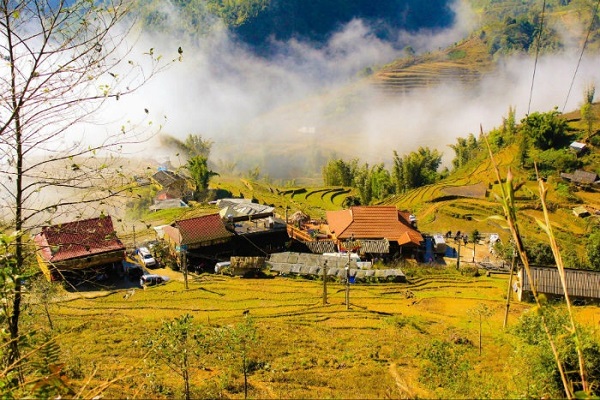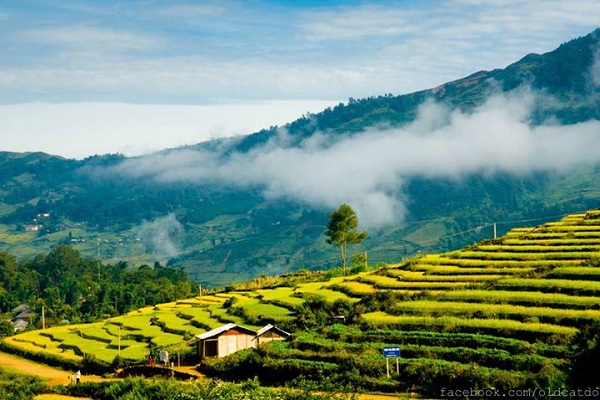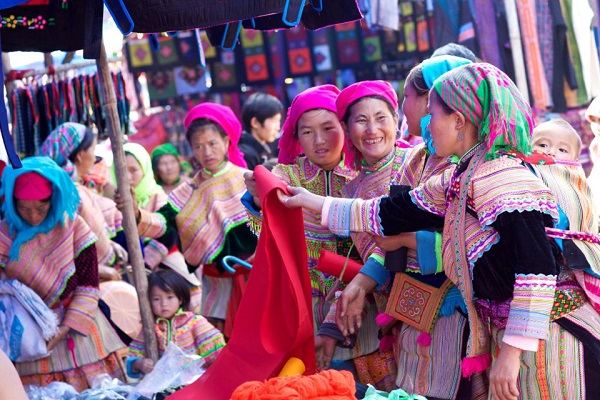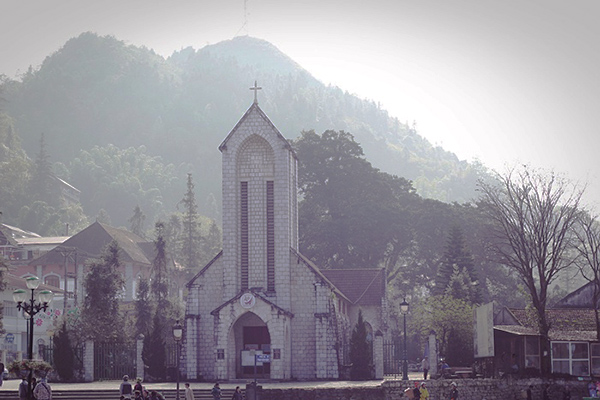The main reason making almost tourists coming to Sapa is to explore the experience scenic destinations, learn the culture of the ethnic minority living in the Northwest. For distance, the tourists not only grace the beauty the top of Sapa’s destinations but also have the chance to enjoy a unique culture characteristic of mountains northwestern. In the article, we offer the best Sapa tour 3 days 4 nights for tourists.
Sapa is one of the most wonderful places in Asia and is a magical combination of landscapes, ethnic cultures, and bracing mountain air, where is located in the middle of the break taking landscapes in the north of Vietnam. There are stunning areas for hiking through lush mountain valleys to the remote villages of different minorities.
Trekking Cat Cat village and Shin Chai village on the first day
Cat Cat village
Cat Cat is the old village of ethnic groups which attracts tourists from all over the world for its distinctive customs and practices. The walk to Cat Cat Village and its nearby hills provide an opportunity to see farms and techniques used by the people in the area. Cat Cat village, the home of the Black H’mong people, who is famous for its brocade weaving craft as well as its gold and silver jewelry making. In fact, it is also a good opportunity to purchase some traditional souvenirs and handicrafts right from the craftsmen such as twisting flax and weaving fabric.
Shin Chai village
This short trek to Shin Chai allows you for cultural acclimatization. Shin Chai is a community village. Here the locals will take the time to teach textile weaving and dying, will take the group on a locally built trail to explain the names and function of the local flora. Shin Chai is a village of the Red Dao ethnic people. The woman in there wear the colorful clothes with distinctive jewelry and an enormous red turban. There will be the opportunity to participate in the village community, there will be a traditional sporting activity and tree planting.
After coming back to Sapa town, you should walk around there. Town of Sapa is where ethnic minority people join together. They can trade or sell their farming products such as rice, corn, fruits, as well as handicrafts and souvenirs to tourists. You will have a chance to discover the local of ethnic minority people by many stories as small children, can speak English pretty well with clear pronunciation.
Exploring Lao Chai village, Ta Van village and Giang Ta Chai village on the next day
Lao Chai village
Lao Chai village is 6 kilometers far from Sapa town, where is a home of black H’mong people. From the above, you can admire a great view of the whole village open wide to offer the marvelous panorama of the village, backed by high mountains and facing the river. Going to visit this village, you will enjoy the fresh air, see terrace fields, stream. Not only that you also discover deeply some of the H’mong’s families. There are three large villages including over 100 families of the ethnic, especially, local people are quite hospitable. To have more understanding about their culture and customs, you can ask them. The same other villages, local people in Lao Chai village also has the experience rice intensive farming on the lower land near the bottom of the valley. And they grow corn on the mountain slopes at the back of the village. It is the main their income.
Ta Van village
Ta Van village is a place where many Vietnam ethnic minority groups live during a long time in harmony. Coming to this village you know how they make their traditional clothes, handicraft, indigo… Otherwise, you will visit the biggest valley which offers to the awesome landscape of the golden rice terraced field in Vietnam. Dzay people live in Ta Van village. It is a small group of ethnic people living in Northern Vietnam, they still keep a rich and traditional culture. There are many delicious foods such as Bamboo cooked rice (Com Lam) cooked by sticky rice, five-colored “Xoi Nam Mau”, chicken of Mong ethnic people, fruits… However, street foods are not cheap.
Giang Ta Chai village
Giang Ta Chai is one of the most attractive places in Sapa tour 3 days 4 nights. Located on the right side of Muong Hoa Valley, Giang Ta Chai is the home of Red Dao so it has become of the interesting place to someone who wants to experience the colorful traditional customs. Besides, it is situated in the opposite to Muong Hoa stream and it was hidden by old trees and bamboo groves. Maybe you haven’t yet known Red Dao is the second biggest ethnic group people in Sapa in Vietnam. Continuously, you will be attractive immediately by the traditional costumes of the local people; and most of those clothes are made from natural materials. Have an overnight at home stay of local people, you have a chance to experience the lifestyle of Red Dao through their folk songs, traditional dances or their handicrafts.
Muong Hoa Valley
Muong Hoa is known as the largest farmland for rice growing in SaPa, which is one of the most famous places for breathtaking scenery. It is far from town about 14 kilometers. To approach Muong Hoa Valley, you can trek along Muong Hoa River. This valley is located between two high limes of mountain running in parallel south-east of SaPa town. On the way, you can learn more about how is the rice cultivating. Muong Hoa valley is blooming with lots of colorful flowers in a wide range of various beauties.
From afar, you can grace the rainwater follow dozens of streams downhill to the floor forming the Muong Hoa. Continuously, you follow across the small town and rice fields of the ethnic minority people of H’Mong, Dao and many others. They have been working on the sloping land and living their own ways for hundreds of years.
Discovering local markets and Sapa town on the last day
Guide some local markets hold
Sapa is famous for its markets, and on almost every day in the week. Therefore, you don’t worry about missed any markets during the coming time. For distance, Coc Ly Market opens on Tuesday which is a great place to buy traditional costumes and to learn more about the local culture. On Wednesday, Sin Cheng Market is a small market in the Si Ma Cai district, where you can meet several ethnics of the White H’Mong, Flower H’Mong, Tay and Black Dao who sell the beautiful traditional costumes. Sometimes the market can be hard to reach due to road conditions. After one day, Lung Khau Nhin is located high in the mountains of the Tram Ton pass. Various small tribes such as the H’Mong, White Tai and Tai Lu are gathering to sell their products. There are two largest markets organized in the weekend like Can Cau Market and Bac Ha market. Can Cau market is located only 7 kilometers from the Chinese border, and just like the other markets, a fascinating and authentic experience. The most famous and biggest market of Sapa is Bac Ha. You can buy several products, such as handicrafts, traditional costumes, and food. Various tribes are gathering at this market.
Sapa Love market
Only taking place on weekly Saturday evening, Sapa’s Love market is the most attractive destination for tourists. It has been unique and valuable aspect of the culture of the Mong and Dao ethnic groups for a long time. Love Market is where local teenagers coming from the surrounding minority villages to join together. They gather to sing, charm, and find love. The Love Market has been kept on the long time, but modern life has made the market seem to lose its tradition.
Sapa Stone Church
Sapa Stone Church is a famous place where holds many traditional cultural activities of ethnic minorities. It is said that the direction of the church is the east, the direction of the sunrise. Sapa church was made from the shaped stones in combination with a mixture of sand, lime, and molasses even from the smallest details; that makes the church becomes more special. Moreover, it is also the main place for keeping many cultural traditional activities of the ethnic people in there.
Finally, Sapa tour 3 days 4 nights will bring for you the best memory and experience to get the unforgettable trip. From the tour, you completely grace the natural scenery and understand the culture of ethnic minorities.





